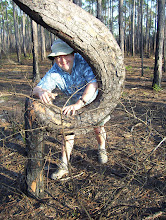 We piled back into the min-vans, and headed east down the South Fulton Parkway, toward Cochran Mill Rd. The drive lasted only a couple of miles, but it was time enough to recover somewhat from the harsh wind and cold of the rather wintery late Saturday morning. By the time we parked the vehicles and crossed the road, the sky had clouded up, and a few flurries were falling, and it felt colder than ever. We paused in front of the outrcop again, to try to make sense of it all, in word or gesture (above).
We piled back into the min-vans, and headed east down the South Fulton Parkway, toward Cochran Mill Rd. The drive lasted only a couple of miles, but it was time enough to recover somewhat from the harsh wind and cold of the rather wintery late Saturday morning. By the time we parked the vehicles and crossed the road, the sky had clouded up, and a few flurries were falling, and it felt colder than ever. We paused in front of the outrcop again, to try to make sense of it all, in word or gesture (above). Julie quickly discovered another possible Contact, and this one was much more intriguing. Below was the old standby, Palmetto Granite, with its phenocrysts (large crystals) of feldspar. Above, a series of layers, black and white and intermixed -- a melange of metamorphic material. It was beautiful, and fascinating. It was a Contact where much had happened. The surrounding rock had already been metamorphosed from gosh-knows-what parent rock (shall we take it for granite?), into a well-foliated (layered with minerals) gneiss. Then the granite intruded the gneiss, most likely during the uplift of the Appalachian Mountains, roughly 350 million years ago. The process was an example of regional metamorphism, because it involved the deformation and transformation of rock over a large area, as the result of tectonic forces. The hot magma "baked" the zone where it met the gneiss, causing contact metamorphism, a kind that is localized and usually the result of a magma coming into contact with much colder rock. It was a sort of geological epiphany, to see a metamorphic rock that had, in turn, been metamorphosed again, but in a very different way.
I felt like a college student, back on an introductory geology field trip, getting my eyes opened and seeing rock units in more profound ways than before. It was the kind of experience that is all too rare in book reading (for all the books that I polish off every year) -- a deep knowing that comes from direct encounter, from the experience of witnessing the outcrop and feeling amazement at the story it is telling. This is why geology needs to be taught as a field science, not something that can be learned through "virtual field trips" and computer simulations. What is actually going on out there is much more powerful than what one simply reads about. Maybe T.S. Eliot was right: "Human kind cannot bear very much reality." That discovery, that metamorphosed rock could also be metamorphosed through contact with granitic magma, lingered with me throughout the remainder of the trip, and stays with me now as I type these words. I still recall fondly that moment of enchantment and bliss, there in the bitter wind on that second outcrop of the day, gazing at the Contact and into its secrets.


No comments:
Post a Comment